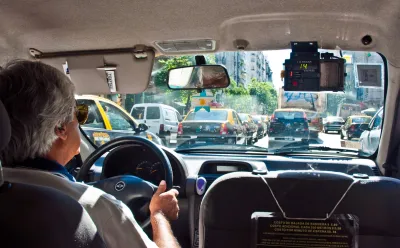The "universal visitation law of human mobility" documented in a newly published study in Nature offers predictive power for urban mobility in addition to empirical validation of Central Place Theory.

A study published last week in Nature reveals a "universal visitation law of human mobility" that could enable new ways to predict the way people move in and around cities all over the globe.
An article by Becky Ferreira shares news of the study led by researchers at MIT’s Senseable City Laboratory, who spent years tapping into anonymized mobile phone data in seven cities representing four continents: Greater Boston, USA; Singapore; Dakar, Senegal; Abidjan, Ivory Coast; and the Portuguese cities of Lisbon, Porto and Braga.
According to Ferreira's explanation, previous mobility research has overlooked "frequency of visitation," which proved to be the key to the advancement in the recent study, namely, the discovery of a "very clear" mathematical law that offers a universal visitation law of human mobility.
Ferreira summarizes the finding thusly:
Despite the dazzlingly distinct skylines, demographics, and characters of the studied cities, the researchers found that their residents and visitors all adhered to this universal visitation law, as described in the study: “the number of visitors to any location decreases as the inverse square of the product of their visiting frequency and travel distance.”
Of tremendous relevance to planners, "the new approach can provide more accurate predictions about all kinds of urban exchanges and encounters."
Ferreira also reports another consequences of the study's discover of the universal visitation law of human mobility: "The new law also provides empirical validation for established theories about human mobility such as the Central Place Theory, which suggests that people visit the closest possible location for their needs or wants, leading to distinct clusters within settlements."
FULL STORY: Millions of People's Location Data Revealed a 'Universal' Pattern In Study

Analysis: Cybertruck Fatality Rate Far Exceeds That of Ford Pinto
The Tesla Cybertruck was recalled seven times last year.

National Parks Layoffs Will Cause Communities to Lose Billions
Thousands of essential park workers were laid off this week, just before the busy spring break season.

Retro-silient?: America’s First “Eco-burb,” The Woodlands Turns 50
A master-planned community north of Houston offers lessons on green infrastructure and resilient design, but falls short of its founder’s lofty affordability and walkability goals.

Test News Post 1
This is a summary

Analysis: Cybertruck Fatality Rate Far Exceeds That of Ford Pinto
The Tesla Cybertruck was recalled seven times last year.

Test News Headline 46
Test for the image on the front page.
Urban Design for Planners 1: Software Tools
This six-course series explores essential urban design concepts using open source software and equips planners with the tools they need to participate fully in the urban design process.
Planning for Universal Design
Learn the tools for implementing Universal Design in planning regulations.
EMC Planning Group, Inc.
Planetizen
Planetizen
Mpact (formerly Rail~Volution)
Great Falls Development Authority, Inc.
HUDs Office of Policy Development and Research
NYU Wagner Graduate School of Public Service




























